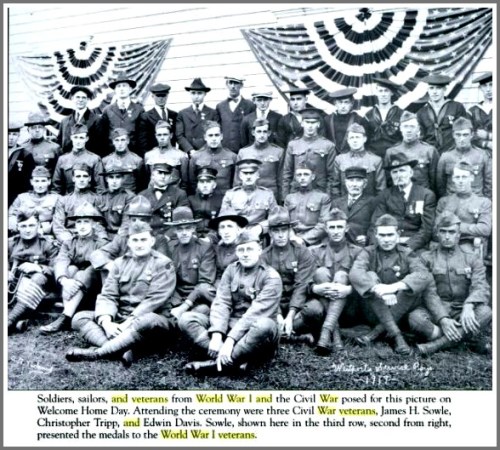The page has turned on this year’s WestportREADS.
This year’s program — in which the entire town is encouraged to read the same book, then participate in discussions, lectures, videos and more — focused on “Regeneration.” Pat Barker’s historical fiction features a British officer who refuses to continue serving during the “senseless slaughter” of World War I.
The novel inspired Kathie Motes Bennewitz to do some digging.
The town arts curator knew that when “The Great War” began, Westport was already a thriving arts colony.
What, she wondered, was the connection between local artists and World War I? Kathie writes:
Over 220 Westport men fought in the US armed forces. Many were “doughboys,” a nickname given to soldiers in the American Expeditionary Forces.
We know from wartime draft records the names of many artists who lived here in 1917, as every man ages 18-45 was required to register. Among the residents were Karl Anderson, Edmund M. Ashe, E. F. Boyd, Robert Leftwitch Dogde, Arthur Dove, Ernest Fuhr, Ossip Linde, Lawrence Mazzanovich, Henry Raleigh, Clive Weed and George Hand Wright.
While Ashe, Mazzanovich and Dodge registered as national guardsmen with the Connecticut Militia, many others were too old to do so. So they used their talents to serve the home front in other ways.
Editorial cartoonist Clive Weed, a summer resident since 1910, made spirited illustrations on wartime events, like this one: “He Might Be YOUR Boy,” for the Philadelphia Public Ledger.

George Hand Wright drew similar illustrations.
Other Westporters — including Ashe, Boyd, Fuhr, Raleigh and Wright — created graphic posters to recruit servicemen and nurses, or urge citizens to purchase Liberty Bonds to finance the war. One example is Ashe’s “Lend the Way They Fight” (below), which shows an American infantryman hurling a hand grenade at German soldiers in a trench on the western front of France.

Hundreds of posters like this were made, raising $21.5 billion for the war effort. Here’s one from Raleigh:

In August 1918 — only months before the war ended — Anderson joined creative and patriotic forces with his Westport neighbors Mazzanovich and Linde to paint a billboard advertising war stamps, in downtown Bridgeport. The trio were filmed in action by the government for a newsreel, which was shown in movie houses nationwide.
When the war ended, younger artists flocked to Westport.
Kerr Eby, James Daugherty, and Ralph Boyer and his future wife Rebecca A. Hunt had each served as camoufleurs. They painted camouflage — a novel and demanding job.
Eby — assigned to the Camouflage Division of the US. Army 40th Engineers, Artillery Brigade in France — had it the hardest. Working on the front, he produced camouflage for artillery and troops. He also made drawings of the horrific images he witnessed on the battlefield.
Boyer and his art school friend Daugherty were both assigned to Baltimore for another important job: to execute “dazzle” painting designed to protect Navy vessels from enemy site and fire.
This new art involved painting abstract murals on ships that would soon be loaded with troops and ammunition. Swinging from a bosun’s seat, the artist laid the design on the side. A gang of painters followed rapidly behind, cutting in the geometric pattern with precision.

USS Leviathan in “dazzle” camouflage, 1918.
“The result was supposed to confuse and befuddle the German submarine gunner,” Daughtery said. “It could hardly do less.”
Of course, Westport’s most enduring legacy of World War I is the Doughboy statue at Veterans Green, across from Town Hall. Bennewitz explains:
Sculptor J. Clinton Shepherd was another wartime camoufleur. He served in the Illinois National Reserve and Air Corps. When he moved to Westport in 1925, the town had voted to erect a monument to honor its soldiers and nurses, who had returned from the front, and memorialize the 7 who had died.
In 1928 Shepherd received the commission. He sensitively rendered a life-sized soldier “with a pensive expression to memorialize the personal side of that ‘war to end all wars.'”

Dedication of the Doughboy statue in 1930. It was located on the grass median dividing the Post Road, between what is now Torno Lumber and the former Bertucci’s restaurant. This view looks east. The statue was moved in the 1980s to its current location opposite Town Hall (below).

(Photo/Seth Schachter)




















 For
For 

